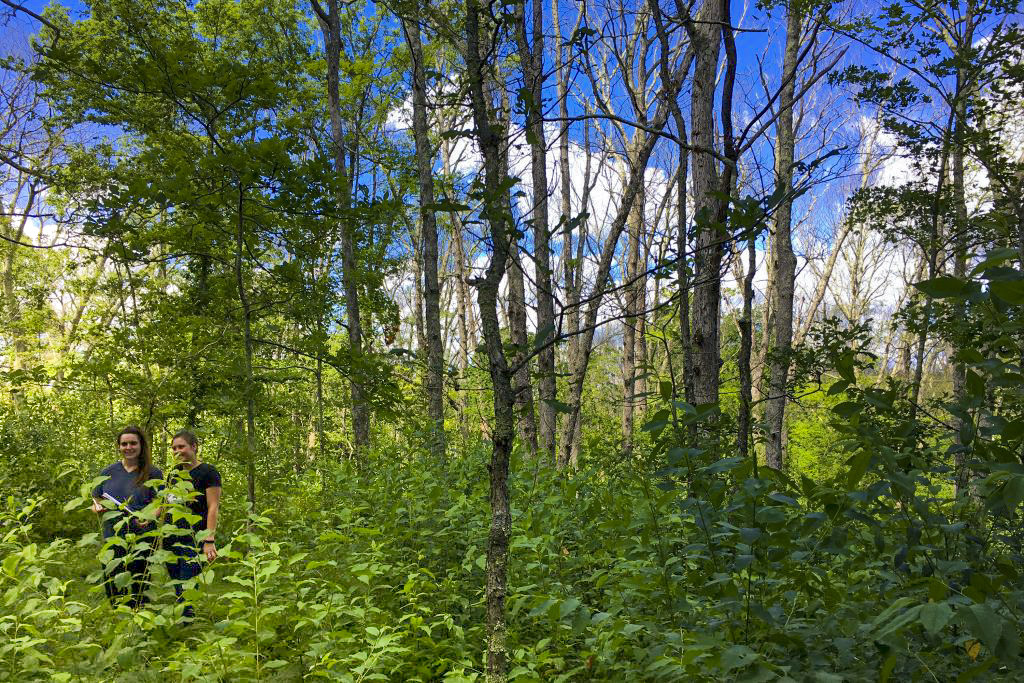Connecticut residents are all too familiar with the damage wrought by gypsy moths in recent years, particularly in the eastern part of the state.
In Windham County, for example, one of the most severely affected areas over the past few years, Canterbury first selectman Christopher Lippke puts the death of trees from gypsy moths along town’s roads at nearly 600.
With their voracious appetites, gypsy moth caterpillars are able to defoliate trees, particularly oaks. While healthy trees usually recuperate, the extent of the damage along with drought conditions over the past few years has impeded their recovery.
To help deal with the moths’ devastating impact on the environment, Lippke and many others in eastern Connecticut have engaged the resources of UConn Extension.
UConn’s Tom Worthley an associate extension professor with a joint appointment in the Department of Natural Resources and the Environment, is at the forefront of this effort. He has met with homeowners, landowners, and community leaders throughout Connecticut’s Quiet Corner to offer advice on how to control the gypsy moth population even before an outbreak, what can be done in the midst of one, and how to mitigate damage to trees.
Dead trees are more dangerous the longer they are left to stand. Time is of the essence. — Tom Worthley
Recently, he has spent much of his time addressing tree mortality.
“During the spring and summer of 2018,” says Worthley, “the impact of previous years’ drought, defoliation, and secondary opportunistic pathogens became apparent as tens of thousands of roadside trees throughout eastern Connecticut and thousands of acres of oak woodlands exhibited severe mortality.”
He notes that both state forest lands and many private parcels in eastern Connecticut have been affected, with severe canopy loss on tens of thousands of acres, and partial canopy loss on many more, from the Rhode Island line west to the other side of the Connecticut River.
In Canterbury, Worthley worked with UConn students to assess the extent of the damage, recording stretches of roadway with 30 to 40 dead trees per mile. And he formed a working group of town and state officials, representatives from utility companies, and members of the forestry and arboricultural communities, to coordinate efforts to address the issues.
“Tom got the ball rolling for us,” says Lippke, the first selectman. “His expertise and knowledge are helping us be proactive rather than reactive.”
Dead trees can be hazardous. Falling trees and branches can injure people, damage property, hinder commuters and emergency responders, and bring down power lines. Dead wood also increases the risk of wildfires. Because of this, Canterbury, like many other towns, is facing prohibitive costs, as the cost of cutting down a single tree can be hundreds of dollars.
In addition to local efforts, Worthley is also working at the statewide level. He has convened several meetings of stakeholders concerned about dead roadside trees as potential safety hazards, including representatives from the public utilities, the state departments of transportation and energy and environmental protection, professional arborists, tree wardens, and others. He emphasized the extent and seriousness of the problem, and encouraged communication and cooperation.
Last month, Worthley and other forestry experts guided Rep. Joe Courtney through Pachaug Forest to survey tree damage. Recognizing the cost of clearing dead and dying trees, Courtney is exploring the possibility of using federal funds to address gypsy moth outbreaks.
“The scale and scope of tree mortality in eastern and central Connecticut is a potential public safety hazard and a problem beyond the capacity of towns, the Department of Transportation, and utilities,” says Worthley. “Dead trees are more dangerous the longer they are left to stand. Time is of the essence.”



